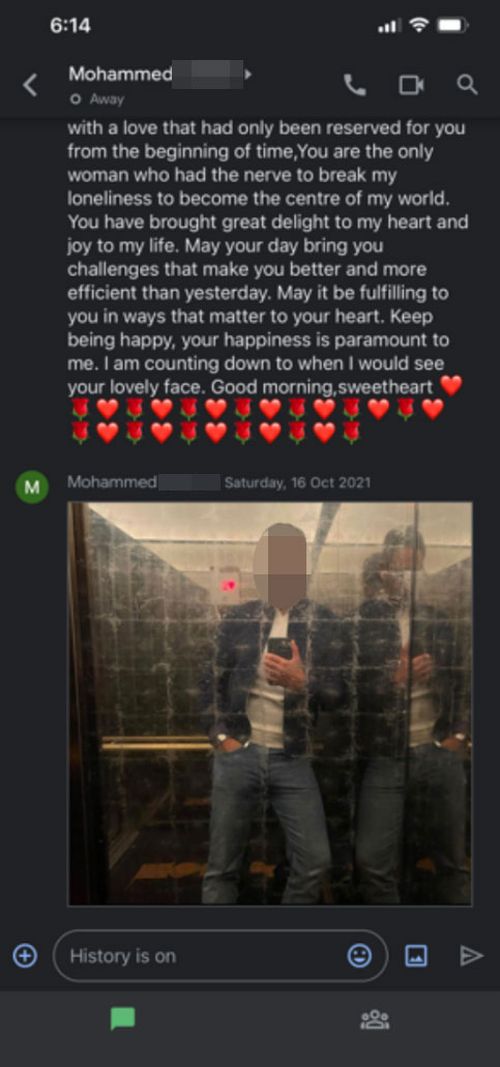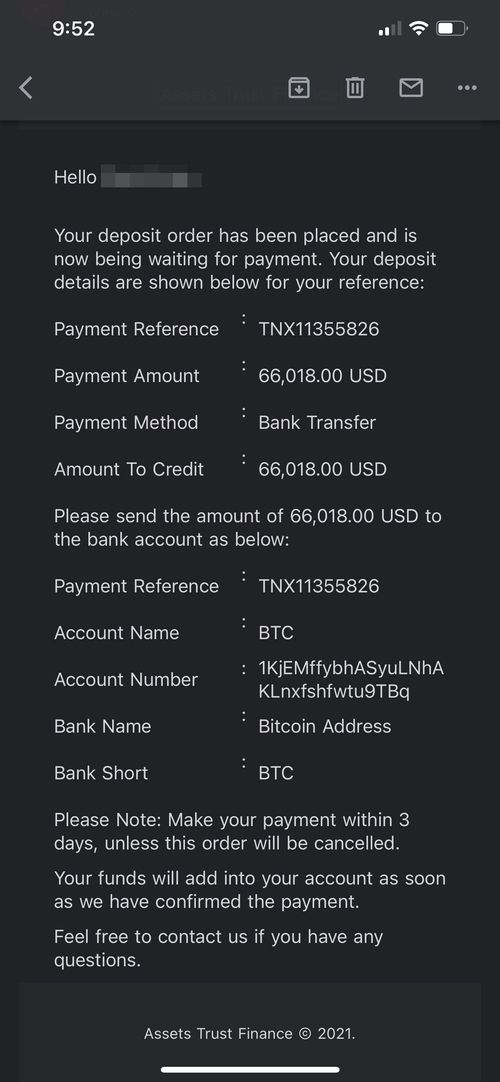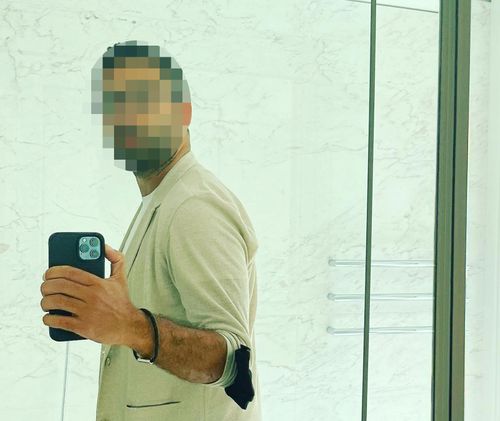Tasmanian single mum Amanda* didn’t hesitate to accept the invitation from the man, who called himself Mohammed, after also spotting him under the “people you may know” section of her own Facebook page.
“He was attractive and cute, I thought, ‘Okay, why not’,” Amanda told 9news.com.au.

At the beginning, their conversations were innocuous enough.
“It was just normal chat, ‘Hello’ and ‘How are you today?’ that kind of thing,” she said.
But, pretty soon it turned into something more.
“We were getting along really well. We had this kind of chemistry,” she said.
“Soon we were chatting every day – day and night, really.”
Mohammed told Amanda he was a cryptocurrency trader living in Washington.

(Supplied)
He was prolific, sending messages and photo updates of his day, along with flowery declarations of his love.
Early on in their online relationship, Mohammed made a video call to Amanda, so they could speak in person.
In the video, he appeared exactly as he did in his photos.
“I was looking at him and talking to him – it was him,” Amanda said.
It would take Amanda six months to unravel a devastating truth – that nothing she thought she knew about their relationship was real – but not before she had been scammed out of about $120,000.
Amanda later found out that the photos Mohammed had been sending her of himself were actually pilfered off another Facebook profile, that of a suave London real estate agent.
She assumes the video call Mohammed made to her was a “deepfake” as the background showing during their conversation matched another video posted by the same real estate agent on his Facebook page.
“It was so convincing, you would never know. I was completely and utterly fooled by it,” Amanda said.
Amanda said it was almost three months into their relationship before Mohammed first mentioned she should invest in cryptocurrency.
“He said, ‘I’m making a lot of money and I want to introduce you to it, so you can make a lot of money too’,” she said.
“It was for the future we were planning together.”
Amanda found out there was a Bitcoin ATM a few hours’ drive from her home in Tasmania, where she could deposit $9990 a day in exchange for the cryptocurrency.

Mohammed showed her a cryptocurrency platform where he said he had already invested his money.
“He showed me a screenshot of his own account, which had about $2 million in it,” she said.
To be safe, Amanda said she only bought a small amount of cryptocurrency at first, which she deposited into her trading account on the platform.
“I then tried to withdraw my money, to see if I could put it back in my account, which I could,” she said.
Convinced then that the investment was legitimate, Amanda put the money back again into her cryptocurrency account.
She soon began investing larger amounts, even selling some shares she owned to buy more cryptocurrency.
But, a few months later, the cryptocurrency platform suddenly went offline.
Amanda was told it was undergoing maintenance.
Weeks went by before the cryptocurrency platform reappeared, but under a new name.
“I could still log in, my money was still there, but when I tried to withdraw it, I couldn’t get any of my money,” Amanda said.
It was around the same time that Amanda was starting to question everything she knew about Mohammed.
Who is the real Mohammed?
One day, she did a reverse image search on Google which led her to the social media profiles of a London real estate agent, who is entirely innocent and in no way connected to the scheme.
9news.com.au has made contact with the real estate agent whose images were used. He requested not to be identified for privacy reasons.
Amanda said when she angrily confronted Mohammed about the images, he led her to believe he was in fact the real estate agent, but had assumed a false identity to protect the public image that came with his job.
“You know me too well babe. You’ve seen me. I just fell in love with you because you’re not after anything but just me and love,” he wrote in a message to Amanda.
“I know you knew I was a big public figure but kept low.”

Meanwhile, the operators of the cryptocurrency platform Amanda invested with suddenly ordered her to pay what they called “signal fees”.
The amounts charged escalated from $US1000 ($1537) to $US1300 ($1998), and finally $US17,550 ($26,980).
“I paid the first two signal fees but then I had to stop because I knew it was not right and I was being scammed,” Amanda said.
Angry, hurt and reeling from the extent of her financial losses, Amanda cut off all contact with Mohammed.
But when he reached out to her a few months later, she began speaking with him again in a bid to find out what happened to her money.
It was then Mohammed confessed to her the details of the scam.
Amanda said her deepest sense of betrayal came when he told her he was just one of the “Mohammeds” she had been speaking to.
“I thought I was talking to one guy. I later found out I was talking to five different guys on the same account,” she said.
“They were all rotating in different shifts so they were available to me all the time. All five of them shared my money.”

Amanda said she had been left financially and emotionally broken by the experience, which ended in June this year, almost exactly a year after it began.
“I’ve been fooled, I’ve been betrayed. I thought I was in love and I’m still hurting a lot.”
While Amanda said she felt lucky to have a job to keep her financially afloat, the amount she lost represented savings she had painstakingly put away for 25 years.
Amanda said she hoped sharing her story would help prevent others from falling victim to similar scams.
Tens of millions lost to catfishing scams
On average, victims lost around $11,000 each, with 2644 reports received by the agency since the beginning of this year.

The most common way for scammers to contact new victims is through dating sites and social media.
This year has so far been an improvement on 2021, when a whopping $56 million was lost to romance scams.
- It takes only a few conversations for someone you met online to declare they have strong feelings for you. They will often try to move your conversation from the platform where you met, asking you to communicate via chat or email.
-
Their profile on the internet dating website or their Facebook page is not consistent with what they tell you about themselves.
-
They may spend a long time gaining your trust – often weeks, months or even years – before spinning an elaborate story to ask for money.
-
Their messages are often poorly written, vague and escalate quickly from introduction to love.
-
If you don’t send money straight away, their messages and calls become more persistent. If you do send money, they will ask you for more.
-
They don’t keep their promises and always have an excuse for why they can’t travel to meet you and why they always need more money.
(Source: Scamwatch)
*Name has been changed for privacy reasons
